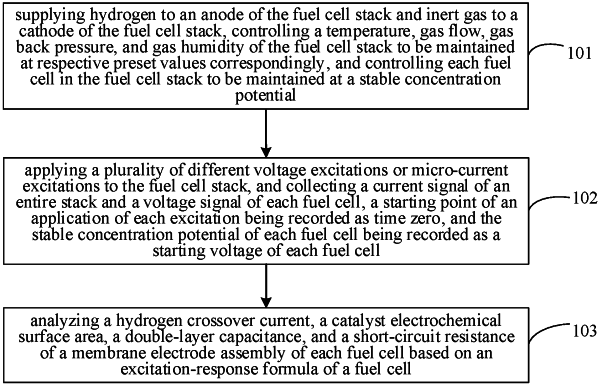| CPC G01R 31/396 (2019.01) [G01R 31/382 (2019.01); H01M 8/04552 (2013.01); H01M 8/04589 (2013.01); H01M 8/04641 (2013.01); H01M 8/04701 (2013.01); H01M 8/04753 (2013.01); H01M 8/04828 (2013.01); H01M 8/1004 (2013.01)] | 9 Claims |

|
1. A method for simultaneous detection of a plurality of parameters of a plurality of membrane electrode assemblies of a fuel cell stack, comprising steps of:
supplying hydrogen to an anode of the fuel cell stack and inert gas to a cathode of the fuel cell stack, controlling a temperature, gas flow, gas back pressure, and gas humidity of the fuel cell stack to be maintained at respective preset values correspondingly, and controlling each fuel cell in the fuel cell stack to be maintained at a stable concentration potential;
applying a plurality of different voltage excitations or micro-current excitations to the fuel cell stack, and collecting a current signal of an entire stack and a voltage signal of each fuel cell, a starting point of an application of each excitation being recorded as time zero, and the stable concentration potential of each fuel cell being recorded as a starting voltage of each fuel cell; and
analyzing a hydrogen crossover current, a catalyst electrochemical surface area, a double-layer capacitance, and a short-circuit resistance of a membrane electrode assembly of each fuel cell according to an excitation-response formula of a fuel cell, the excitation-response formula of the fuel cell being:
 where ich represents a real-time excitation current density or a real-time response current density under a voltage excitation, iH represents a hydrogen crossover current density, QCata. represents a real-time total amount of charges absorbed and desorbed on a surface of a catalyst, Cdl represents the double-layer capacitance, U represents a real-time voltage of a single cell, U0 represents a starting voltage of the single cell of a single excitation, Re represents the short-circuit resistance, and t represents time,
wherein data of each single fuel cell is analyzed separately, a voltage window of an initial analysis is set to [U1, U2], the voltage window corresponding to a voltage interval after a completion of hydrogen desorption and before a start of oxygen adsorption, all data in a range of the voltage window is processed, and it is set that:
 when the formula (1) is used for an analysis, ternary linear regression is performed based on Y=a0+a1X1+a2X2+a3X3 to obtain coefficients of respective terms, and to obtain the plurality of parameters of a fuel cell membrane electrode:
 when formula (2)
 is used for an analysis, binary linear regression is performed based on Y=a0+a1X1+a2X2 to obtain the plurality of parameters of a membrane electrode:
iH=a0,QCata.-H=a1,Cdla2 (5),
where QCata.-H represents a total amount of charges of hydrogen desorption, and the catalyst electrochemical surface area is analyzed by the total amount of charges of hydrogen desorption:
 where ECSA represents the catalyst electrochemical surface area, ΓCata. represents an amount of charges required to cover the surface of the catalyst completely with a single layer of adsorption hydrogen, and LCata. represents catalyst loading of a measured electrode;
when the formula (1) is used for an analysis, the real-time total amount of charges absorbed and desorbed on the surface of the catalyst in a full voltage range under all excitation conditions is solved reversely:
 when the formula (2) is used for an analysis, the real-time total amount of charges absorbed and desorbed on the surface of the catalyst in the full voltage range under all excitation conditions is solved reversely:
QCata.=∫0tichdt−iHt−Cdl(U−U0) (8), and
it is checked whether QCata. meets a preset condition in the voltage window [U1, U2], if not, the voltage window is adjusted and the analysis is repeated until the preset condition is met, the preset condition being that a standard deviation of all data of QCata. in the voltage window is smaller than a limit value.
|